What are Composite Filaments for 3D Printing?
One of the primary factors that make 3D printing using FDM technology is the wide variety of plastic filaments that have already been developed and manufactured by various brands. There are the usual filaments made from different types of plastic, each with their unique properties. Then there are also the fancier ones – plastic filaments combined with some sort of solid component. As a group, these are called composite filaments.
What exactly are composite filaments and how are they made? When should you be using composite filaments? What are some of the best composite filaments that you could try?
What are composite filaments?
Composite filaments, as the implies, are filaments made from more than just one material. In most cases, it involves a solid in powder form embedded in a plastic matrix. The plastic matrix allows the composite material to behave much like any plastic filament, the most important characteristic of which is that the filament retains its thermosetting properties. Most plastic filaments maintain a ratio of 60% to 70% of the plastic material and 30% to 40% of the solid powder.
For most of these composite filaments, the material of choice for the plastic matrix is PLA. Being one of the most widely used 3D printing filaments, most 3D printing hobbyists and professionals already have a deep understanding of how to get good results with PLA. This also allows composite filaments to be printed at relatively low temperatures. In some cases, the solid component of the composite filament may be prone to burning or discoloration when exposed to high temperatures.
The solid component of composite filaments is what sets them apart from each other. The most obvious effect of the solid component is a marked change in how the filament and, consequently, the finished print looks. This has become the go-to way for mimicking the look of materials that would otherwise have been incompatible with FDM-based 3D printing.
In a few special cases, the presence of the solid component also gives the finished print a few special properties. Composite filaments make it possible to make 3D printed objects conductive, magnetic, or glow-in-the-dark.
When should you use composite filaments?
Composite filaments are also known as specialty filaments for the very reason that you really should only be using them for special applications. If you want to make a 3D printed object that looks like wood or copper, then buying the appropriate composite filament really is the only way to go. They make excellent design pieces and will surely surprise a few people when they find out that they were made using a 3D printer.
The property that prints made from composite filaments lack is durability. While PLA isn’t exactly the most durable filament material, the presence of solid particles embedded in the plastic matrix means that there are fewer “branches” for the polymer to form. We don’t recommend using composite filaments for printing any moving parts or any object designed to withstand sustained or repeated stress.
A few special filaments imbue special properties to the finished print, such as giving them a limited degree of electrical conductivity or ferromagnetism. However, the presence of the plastic matrix interferes with these properties, which means that a conductive filament will never be as conductive as an actual conductive wire or metal.
With this in mind, the best use case of composite filaments should be for display pieces. When it comes to visual appeal, there’s nothing quite like what composite filaments can produce.
Notable examples of composite filaments
Composite filaments have been around for more than five years and are pretty common nowadays. Different filament manufacturers have produced their own versions of these composite filaments, allowing the market to diversify into filaments that are essentially made from the same components but look slightly different. No matter the brand name, most composite filaments will fall into one of these categories:
Wood Filament
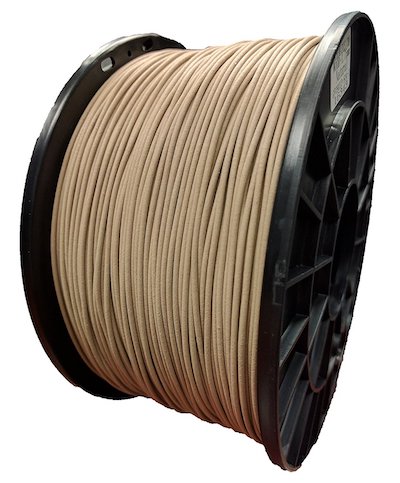
The most widely used composite filament used today, wood filaments have become fairly popular because of how easy they are to handle and how good the results turn out to be. There are actually several flavors of wood filament, each one embedded with wood in a different form. Common examples include bamboo, cork, or wood dust. The physical properties of these different wood filaments may not differ much, but the final results from each one have a distinct look.
What makes wood filaments work so well is that the layer lines that are inherent to FDM printing give the illusion of natural wood grain in the finished prints. This may have been a happy accident on the part of the first person to ever make a wood filament, but this is one of the few times when visible layer lines are desired.
Wood filaments have another avenue of customization because the wood powder can get darker when exposed to higher temperatures. Just make sure not to let your temperature go too high because wood also burns easily and could cause a jam in your nozzle.
Metal Filament
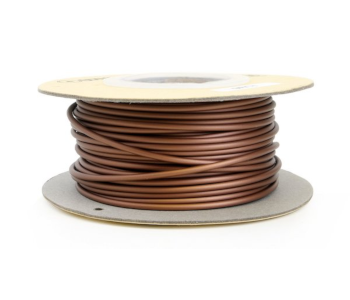
Another popular composite filament, PLA filaments fused with metal powders creates visually striking custom pieces. With a little bit of sanding and polishing, prints made with metal filaments can simulate the luster of real metals.
There are even more flavors of metal filament compared to wood, making this a highly accessible composite filament. Common examples include copper, brass, stainless steel, and aluminum. Metal filaments typically have a higher percentage composition of the solid component – around 80%.
Aside from the superior aesthetics, prints made with metal filaments also tend to have a nice heft because of the metal component. This makes them feel a little more “premium.” If you’re seeking to impress with your 3D printing skills, then a metal-like print is the way to go.
An interesting behavior of metal filaments is that they don’t need to be printed at very high temperatures. The presence of metal in the filament means that the filament heats up even faster than standard PLA and retains a lot of this heat for longer. This means that you can print at low temperatures and run no chance of running into warping problems.
The extra weight that metal imparts could be beneficial in the final product, but it can be problematic during printing, practically if your design has bridges or overhang features. If such features cannot be avoided, we suggest playing it safe and putting support structures.
Conductive Filament
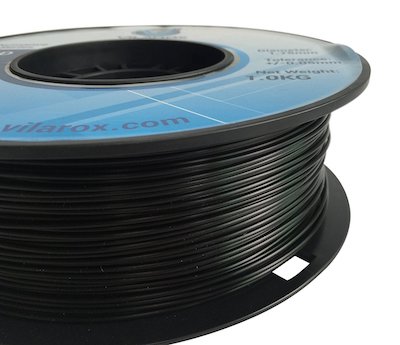
A conductive filament is a bit more special than the other composite filaments in this list. More than its visual appeal, what makes this filament tick is that it can conduct small amounts of electricity. This makes conductive filaments useful for making custom circuitry. Industry experts have even said that conductive filaments may be the future of wearable electronics.
On a more practical scale, conductive filaments can be used to create custom electromagnetic or radiofrequency shields. Think of a Faraday cage that you can build with any shape.
This phenomenon is made possible by infusing plastic matrix with graphene – a compound made of carbon atoms arranged in a honeycomb lattice pattern. Such a chemical structure leaves free electrons that are free to move around, thus transmitting electricity at a limited scale. You’ll have to manage your expectations on this one, as the printed filament doesn’t transmit electricity as well as a real wire.
Graphene is a notoriously expensive material, which means that conductive filament can easily cost up to five times more than the usual 3D printing filament.
Glow-in-the-dark Filament
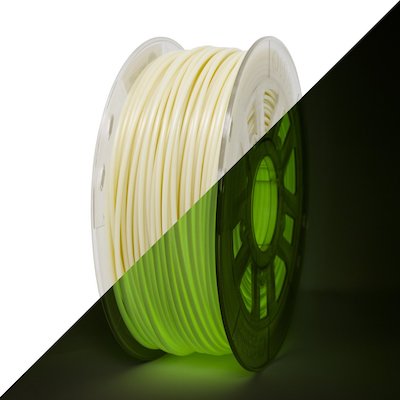
If you like making custom toys and display items using your 3D printer, then a glow-in-the-dark filament certainly sounds like it’s up your alley. Like any glow-in-the-dark toy, a print made from this filament will absorb light from its environment and re-emit it very slowly once it’s plunged into darkness.
The active ingredient of glow-in-the-dark filament is usually strontium aluminate. This is a phosphorescent material that lasts longer and is brighter than older glow-in-the-dark compounds like calcium sulfide and zinc sulfide. Most glow-in-the-dark filaments use either PLA or ABS as the plastic component.
Glow-in-the-dark filament is available in a wide variety of colors, although blue and green are the most popular. You can also control the brightness of the finished print by adjusting the wall thickness settings before printing. The thicker the wall, the brighter glow you’re going to end up with.
Magnetic Filament

Just to be clear, a print made with a magnetic (or more accurately, ferromagnetic) filament will be attracted to magnets. It is, however, NOT a magnet on its own. Although it’s theoretically possible to impart magnetism on a by rubbing it against a magnet repeatedly (a process called ‘hysteresis’), this effect doesn’t last very long and will naturally dissipate over time.
The solid component in the magnetic filament is iron powder, which gives finished prints a characteristic black appearance, some heft and rigidity, and the aforementioned attraction to magnets. If you have a magnetic board set up somewhere in your home or office, then 3D printing stuff to stick on it can keep you entertained for several days.
Don’t be tempted into thinking that magnetic prints are durable just because they are rigid. They are still quite brittle and will fail easily under heavy stress.
A neat technique you can do after you’re done printing with magnetic filament is to post-process your finished print using a technique called ‘rusting.’ This is done by sanding the surface of the print until some of the embedded iron has been exposed. The print is then submerged in saline for up to three days. This accelerates the corrosion process o the exposed iron powder, giving the finished print a characteristic reddish rust finish.
Sandstone Filament
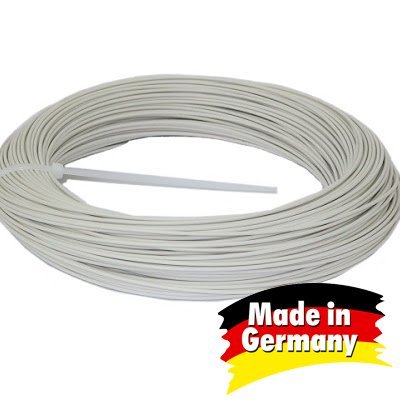
If you’ve ever had dreams of carving a statue out of stone but finding yourself lacking in hammering and chiseling skills, then you can yet make your dreams come true with sandstone filament. This filament is composed of finely milled chalk suspended in a PLA matrix. When used as a filament, the finished print takes on the appearance of a stone carving.
It’s worth mentioning that the solid component of sandstone filament isn’t actually sandstone. Instead, it’s limestone, more commonly known as chalk. Limestone is much lighter and can be ground to smaller particles, making it a better candidate for making composite filaments.
Sandstone prints come out naturally gritty, which is a great way to hide all the layer lines from the printing process. Very rarely are they post-processed, as their raw appearance exudes all the charm of the material. They are quite heavy and brittle, which means the perfect spot for them would in your countertop or desk.
Sandstone prints are very resistant to warping, so that’s at least one problem you don’t need to worry about. However, they also run into the same weight problems as metal filaments. If you have overhanging features in your design, then it’s best to be prudent and provide support structures.
Marble PLA
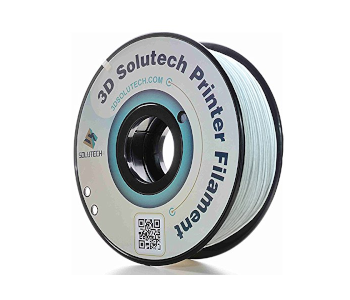
Much like sandstone, Marble PLA provides a way for you to recreate hand-carved statues with much less effort using just your 3D printer. Most Marble PLA is made with a PLA plastic matrix mixed with finely powdered marble.
Once again, you’ll have to manage your expectations when using Marble PLA. Real marble comes with streaks and veins that occur naturally when imperfections intrude into the carbonate-rich rock matrix. This characteristic look of marble cannot be replicated with Marble PLA. Instead, you will need up with black and dark gray specks randomly distributed in a white background. It’s not quite marble but looks closer to how cookies and cream ice cream looks like.
Despite the lack of similarity with the real thing, prints made with Marble PLA still look great. The random speckled look does a great job of hiding the layer lines, although the material also smooths and polishes well.
Carbon Fiber Filament
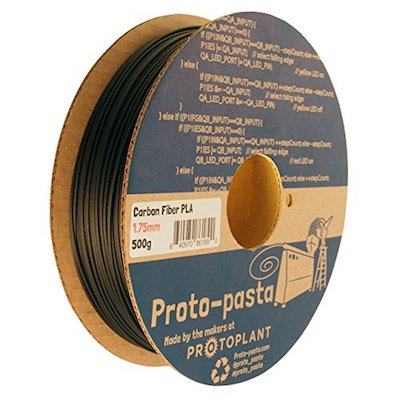
It’s easy to mistake carbon fiber filament to conductive filament since they are both from carbon-based solid components and have a black finish. The main difference is that carbon fiber filament contains pieces of actual carbon fiber – very thin fibers made of carbon bonded together in a crystalline formation.
The distinguishing characteristic of carbon fibers is its very high strength-to-weight ratio, making it the material of choice for applications where a product needs to be both strong and light. As a filament additive, carbon fiber is a rarity in that it enhances the strength of the base plastic rather than weakens it.
The strength of carbon fiber and the size of the solid components in the filament make carbon fiber filament one of the most abrasive. To make sure that your nozzle does not get worn down too easily, you may have to switch out your stock nozzle to one with a larger bore.
Final thoughts
Composite filaments are a way for unconventional materials to be used in combination with 3D printing to create uniquely customized prints. No longer do you need to restrict yourself to prints that look like plastic. With composite filaments, you can push the boundaries of what is possible with FDM technology with prints that look like wood, metal, or stone.
Most composite filaments are a little more expensive that the usual 3D printing filaments. And although they look nice, they are usually less durable than their pure plastic counterparts.

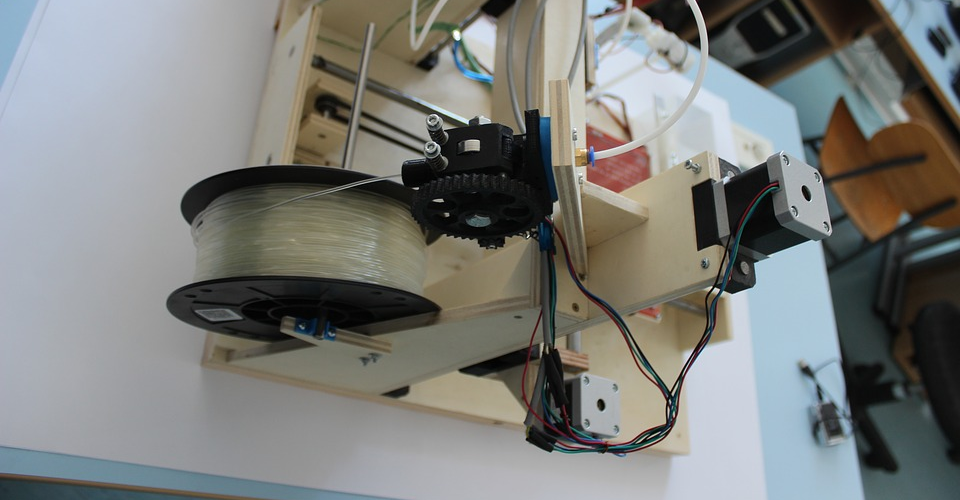

Thanks for the nice breakdown! Some handy tips in here for using these.